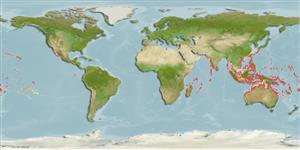Environment: milieu / climate zone / depth range / distribution range
Ökologie
seewasser riff-verbunden; tiefenbereich 0 - 30 m (Ref. 9710). Tropical; 32°N - 35°S, 24°E - 89°W
Indo-Pacific and Eastern Pacific: East Africa to the Mexico, north to southern Japan and the Hawaiian Islands, south to New Caledonia and the Tuamoto Islands. The subspecies Ostracion meleagris camurum is found in the Hawaiian Islands and Ostracion meleagris clippertonense in the Eastern Pacific. Species replaced by Ostracion cyanurus in Red Sea and Gulf of Aden.
Size / Gewicht / Alter
Maturity: Lm ? range ? - ? cm
Max length : 25.0 cm TL Männchen/unbestimmt; (Ref. 3141)
Rückenflossenstacheln (insgesamt): 0; Rückenflossenweichstrahlen (insgesamt): 9; Afterflossenstacheln 0; Afterflossenweichstrahlen: 9. Juveniles and females brown or green with white spots; large males with orange bands and spots on side of body (Ref. 3141). Caudal fin rays 10 (Ref. 3141). Sexually dimorphic (Ref. 37816).
Inhabits clear lagoon and seaward reefs from the lower surge zone to at least 30 meters (Ref. 37816, 48637). Juveniles among rocky boulders, often with long spined urchins, and adults on reef crests and slopes. Males swim about more openly than females that are often in close vicinity to the males (Ref. 48637). Solitary. Feeds on didemnid tunicates, polychaetes, sponges, mollusks, copepods, and algae (Ref. 37816). Minimum depth reported taken from Ref. 128797.
Life cycle and mating behavior
Geschlechtsreife | Fortpflanzung | Ablaichen | Eier | Fecundity | Larven
Myers, R.F., 1991. Micronesian reef fishes. Second Ed. Coral Graphics, Barrigada, Guam. 298 p. (Ref. 1602)
IUCN Rote Liste Status (Ref. 130435)
Bedrohung für Menschen
Venomous
Nutzung durch Menschen
Warning: mysqli::__construct(): (HY000/1040): Too many connections in /var/www/html/includes/func_getlabel.php on line 46
Can't connect to MySQL database (fbapp). Errorcode: Too many connections
